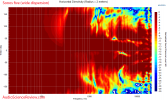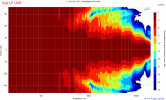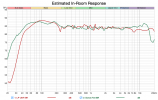This is a review, listening tests, and detailed measurements of the SONOS Five streaming wired/wireless smart multi-room speaker. It was kindly drop shipped by a member and costs US $549.
View attachment 342206
The Five is solidly built and feels rather substantial in hand. Packaging is always is apple-like. Usability however, is quite poor with cryptically labeled buttons with various icons. And blinking lights you are supposed to decode like a world war II Morse operator. Needless to say, the app is must have and this time unlike previous SONOS products I have tested, it found the Five quickly and proceeded to update its firmware. As with physical controls, I find the usability of the app quite poor, requiring me to fumble around to get things done. Touching a two bar icon for example, asked me if I want to "end a session." Say what?
Volume control jumps in big increments of 4 (or more?). Worst thing is the very long latency. Feed it analog audio which you think would play instantly and it takes it good 2+ seconds before it plays. Use airplay and the same long pipeline delay exists. The delay was so long that it confused Klippel standard measurement method, forcing me to opt for a longer scan using asynchronous mode. I wonder if they are using long FIR filters and hence the long latency.
Speaker has an impressive array of three woofers and three tweeters:
View attachment 342207
There is a forward firing tweeter which I used as the acoustic center when scanning using Klippel NFS. There are two side firing tweeters, likely designed to spread the sound and not having it sound like a focused mono speaker. The interference from all three tweeters made for a complicated soundfield. Using my standard measurement scan of 1000 points, I was not able to get high accuracy much beyond 10 kHz (see below). As it is, the scan took five+ hours so I was in mood to double it just to get more accuracy there.
SONOS Five Measurements
Let's start with our array of frequency response measurements per CEA-2034 standard:
View attachment 342208
I must say, with all six drivers whaling, I didn't expect to see such a flattish on axis response. The listening window as indicated in green shows what it averages to which is pretty nice. Even nicer is the impressively low response. It goes deep to 30 Hz! It is boosted in that region but likely to compensate for non-declining high frequency energy due to extra side-firing two tweeters. We can see this effect in early window and predicted in-room responses:
View attachment 342209
View attachment 342210
We will have to listen to assess the tonality as our models don't fit this type of speaker well.
Horizontal directivity is rather chaotic but wide as you can imagine:
View attachment 342211
View attachment 342212
Vertically it looks more typical although we have tall excursions vertically:
View attachment 342213
Distortion is quite high due to two areas of concern:
View attachment 342214
I could not hear them much though as I was listening to the sweep which was cleaner and deeper than many speakers.
View attachment 342215
Note that the graph on the right represents the loudest I could get the unit to play. Bass is around 96 but the rest of the response is closer to 92 dBSPL.
Waterfall display shows a number of resonances:
View attachment 342216
And step response shows the 2+ second latency:
View attachment 342217
A lot of post ringing which I could after the sweep was finished (this happens with a number of active speakers).
SONOS Five Listening Test
I chose to listen to the Five in near-field at about 2+ meters/5 feet. First impression was most impressive. We are talking almost the same accuracy of a studio monitor! Sound was clean, and tonality was right on the money. Bass notes were deep and so much so that they activated the room modes, sounding a bit tubby at times. I made an attempt to reduce that by lowering the hump at 180 Hz and that helped a bit. Forgot to save it though.
At moderate volume, sub-bass reproduction was excellent, way beyond any bookshelf speaker. At max level though, it got distorted. Outside of that region, the sound was extremely nice even when maxed out, producing not only accurate but very pleasing tonality.
I covered the two side firing tweeters with my hand and the sound was still quite good. Taking my hand off gave a wider sense of space without the highs getting bothersome.
Conclusions
What is the old pilot line? Any airplane landing that you can walk out of is a success? Applied here, any smart speaker that doesn't sound like garbage is a major accomplishment. SONOS however, goes way beyond that requirement and produced an excellent sounding speaker that is powerful with very deep bass. Its response is not perfect but comes close to being accurate especially for this class. Side-firing tweeters provide the spacious and wider dispersion that such a speaker needs to have. And triple woofers provide the impressive dynamics. Clearly strong engineering and acoustic design has been used in develop of the Five.
I am happy to recommend the Sonos Five smart speaker.
------------
As always, questions, comments, recommendations, etc. are welcome.
Any
donations are much appreciated using
: https://www.audiosciencereview.com/forum/index.php?threads/how-to-support-audio-science-review.8150/



